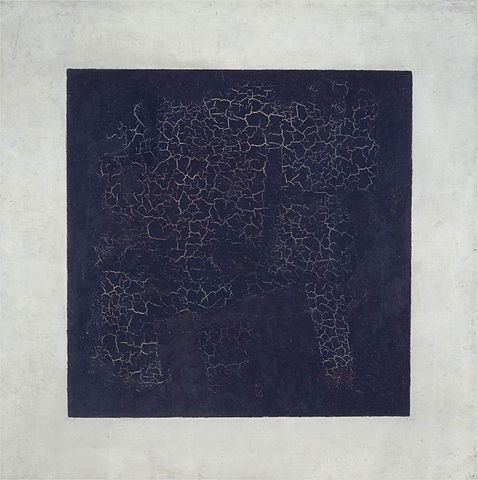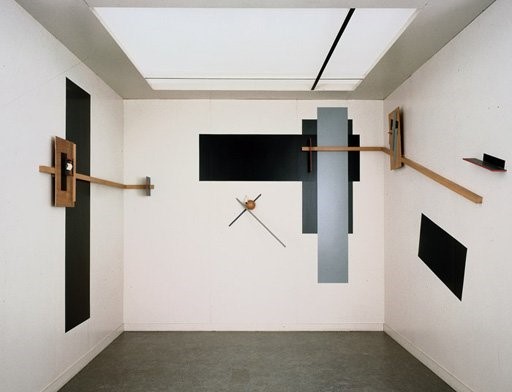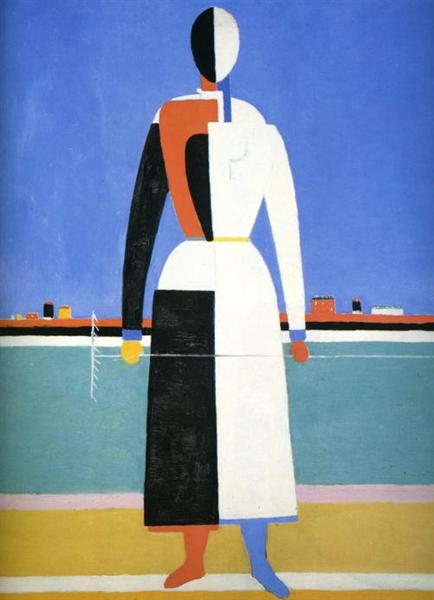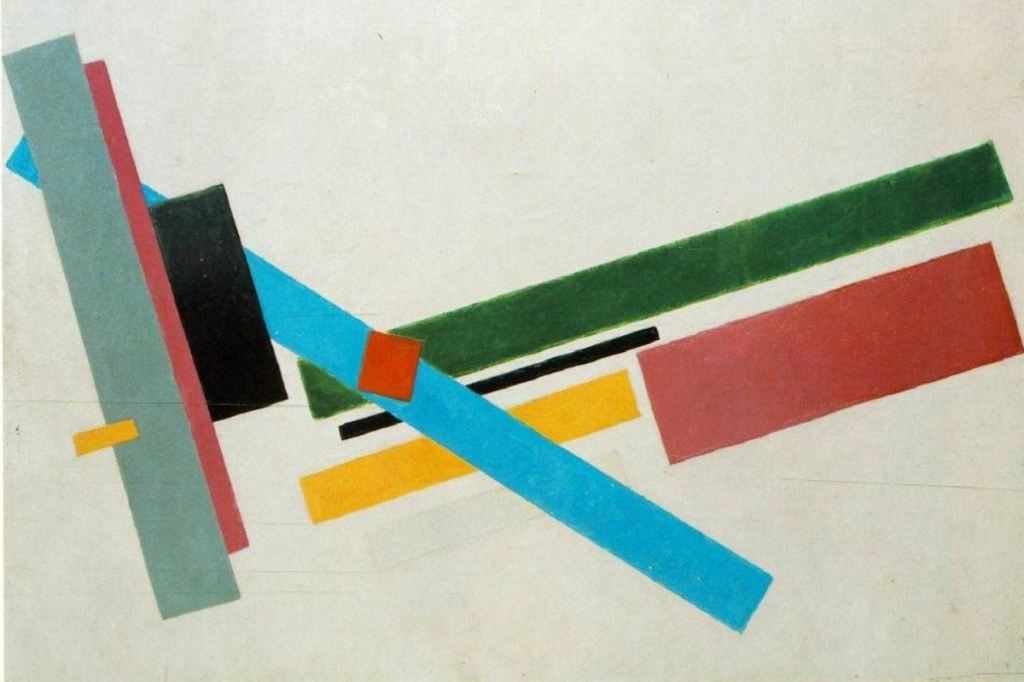Revolutionary Russia now appears as a particularly dense arena for the combat of extreme or polarised beliefs as to the nature of art, and the artist’s responsibility relative to an emerging mass consciousness. In this context, there was a comparatively conscious merger of ideological propositions into what was previously considered a uniquely aesthetic or pure art production. This was a period characterised by transition from creative expression to political repression.
In the context of the Revolution, Suprematism was a transitional art movement, creating a common language between art and the Revolution. Through abandoning established ideals in art and society, Malevich declared: ‘It is absurd to force our age into the old forms of a bygone age.’ In producing works of abstract geometry, he displayed a self-confidence of expression. Malevich and his pupils were set on the idea that Suprematist architecture was ‘capable of reshaping the environment’ during the Revolution in Russia.
The idea of toppling an established system, which previously seemed unmoveable in the context of the Russian Revolution, and the fall of the Tsar assumed precedence in Suprematist works. Malevich’s ‘Black Square’ epitomised this hatred of the established, countering expectations and traditions in the art world. Malevich interpreted his own piece as a ‘new way of seeing space’. This idea of a new way of seeing links fundamentally to the notion of revolution.

Absorbing ideas of the past to build a new creative system brings into question the role of change in revolutions both artistically and politically. If so, does this mean that the work of Malevich underpins the context of the Revolution? In claiming to have rejected the past, the Suprematists needed to have absorbed it; this is a key issue when questioning the Revolution. Scholars have questioned whether Suprematism is better described as creative rebellion rather than a revolution, in as much as it adopted and adapted traditional artistic forms alongside contemporary ideologies. The concept of revolution for the moment superseded evolution in the minds of the masses and the artists alike. What remains to be demonstrated are the particulars of Malevich’s production in these terms.
In contrast to Suprematism, the Constructivist movement may better represent the new socio-political landscape of Soviet Russia post-Revolution. The term constructivism stems from the Working Group of Constructivists, founded in Moscow in March 1921 by Karl Ioganson, Konstantin Medunetski, Alexander Rodchenko, Varvara Stepanova, Georgii and Vladimir Stenberg. The movement was concerned with literally and figuratively constructing a better world through collective action of creators, in contrast to visual works created by individual artists. Suprematism, manifesting itself in painting, as well as in writing and architecture, was not motivated by utilitarian goals. Suprematism mirrored the anarchy of the period surrounding the Russian Revolution, while Russian Constructivism considered thoughtful and ambitious design as a driver of a new order. However, the Soviet state had other purposes for art. Rather than a tool for creating a new order, visual, written, and musical arts were to glorify the worker, peasant, and the nation.
Bridging the divide between Suprematism and Constructivism is the artist Lissitzky. In late 1921, the Soviet government sent Lissitzky to Berlin on a cultural-diplomatic mission to forge relations with artists there. The following year, he became a founding member of the International Faction of Constructivists, based in Berlin. He served as a bridge among Suprematist ideals, Russian Constructivist practical goals, and the International Constructivist use of Constructivist aesthetic and formal ideals with Suprematist focus on personal psychological effect. In painting, he developed an abstract, geometric, architectonic style, which he called “Proun,” an acronym for the Russian phrase “project for the affirmation of the new”. Among the most ambitious Proun works was the Proun Room (Prounenraum). This installation was created for and exhibited in the 1923 Grosse Berliner Kunstaustellung (art exhibition).

Proun Room was part of Lissitzky’s elaboration of Constructivism, retaining the visual realm of flexibility of art within a built environment. Thus, the work was not merely pictorial, but functioned as a useable design. In this way, Lissitzky manifested a role for art within Constructivism. Indeed, the installation allowed the artist to give the viewer art in four dimensions, as he scripted the path through the three-dimensional space.
Constructivists, such as Vladimir Tatlin, El Lissitzky, Popova and Rodchenko, strove to square the circle between the concrete forms of architecture and photography and the values of art for art’s sake. Their structural designs were sharp and angular, a sort of three-dimensional Suprematism. They produced street art celebrating the Revolution and denouncing its foes. In 1919, they covered buildings of Vitebsk in vibrant propaganda, with Lissitzky’s emblematic ‘Beat the Whites with the Red Wedge’, reducing the complexity of Russia’s civil war to a red triangle piercing a white circle, in a geometric confrontation of good and evil that even the least educated could comprehend. ‘The streets shall be our brushes,’ said Mayakovsky, ‘and the squares our palettes.’
The Bolsheviks at first were tolerant, preoccupied with more pressing matters. But by the mid-1920s, the regime was looking disapprovingly at the radicalism and the abstraction, and began to shape the doctrine that would subjugate all art to the aims of socialism. On 23 April 1932, the Central Committee announced the formation of the Artists’ Union of the USSR, tasked with imposing Socialist Realism as the only acceptable form of artistic expression. From now on, it decreed, art must depict man’s struggle for socialist progress towards a better life. The creative artist must serve the proletariat by being realistic, optimistic and heroic. The experimentalism that had flourished since the Revolution was now deemed un-Soviet. To further the cause of the Revolution, the culture must be comprehensible by the masses; anything more complicated, innovative or original was, by definition, useless, and potentially dangerous. The era of freedom for the avant-garde was over.
In 1932, a jubilee retrospective of trends in post-revolutionary art took the celebration of diversity as its keynote. When Artists of the Russian Federation over Fifteen Years 1917–1932 opened at the State Russian Museum in Leningrad, it filled one-hundred rooms with nearly two-thousand works, ranging from heroic statues and paintings of Lenin and Stalin to the striking paintings of Pavel Filonov, teeming with figures. By the time the exhibition was due to move to Moscow in 1933, diversity was a dirty word and many of the contributors were on Kremlin’s blacklist. Malevich, who had already been interrogated by the NKVD secret police, was far less visible in the show. (‘From the first days of the revolution,’ he told his interrogator, somewhat tongue-in-cheek, ‘I have been working for the benefit of Soviet art…’ and ‘Art must provide the newest forms… to reflect the social problems of proletarian society.’)

Under political pressure, Malevich adopted a new enigmatic realism that seemed to contradict many of the fundamental values he had striven for. After Stalin’s rise to power in 1924, the near prohibition on Soviet abstraction and his 1927 tour of Germany, he returned to his earliest subject – the everyday lives of rural peasants – via a highly stylised figurative painting. Had Suprematism been extinguished by the impossibility of public presentation, or had it come to its conceptual end?
Despite the Revolution bringing the prospect of expression and artistic freedom, the tide of politics ultimately turned against many artists. Some were interned in the gulag system while others fled and renounced their art. What the Revolution affected was a potential for consideration of what had previously been present only as an ideal or conceptual tradition and one that had remained historically untenable until that moment. Malevich was both the victim of historical circumstances, in that his idealistic state did not become a political reality, and a self-conscious recipient of enormous responsibility. Suprematism may have failed in the extent of its ambitions corresponding to the fate of the Revolution it supported, but its commitment remains a source of energy for the future towards the realisation of such ethical art.
Written by Jack Bennett
Bibliography
Jager, Nita. Russian Art of the Revolution. New York: Cornell University, 1970.
Lodder, Christina. ‘El Lissitzky and the export of Constructivism.’ in Situating El Lissitzky: Vitebsk, Berlin, Moscow. 27-45. Edited by Nancy Perloff and Brian Reed. Los Angeles: Getty Research Institute, 2003.
Malevich, Kazimir. “From Cubism and Futurism to Suprematism: The New Painterly Realism.” in Post-Impressionism to World War II. 130-145. Edited by Deborah Lewer. Malden, MA: Blackwell, 2006.
Malevich: Suprematism and Revolution in Russian Art 1910-1930. Edited by Larissa Zhadova. New York: Thames and Hudson, 1982.
Shatskikh, Aleksandra. Black Square: Malevich and the Origin of Suprematism. New Haven: Yale University Press, 2012.


One response to “From Creativity to Repression: Art and Revolution in Russia, 1905-1935”
Russian art from early last century is so exciting! I love it so much….
LikeLike